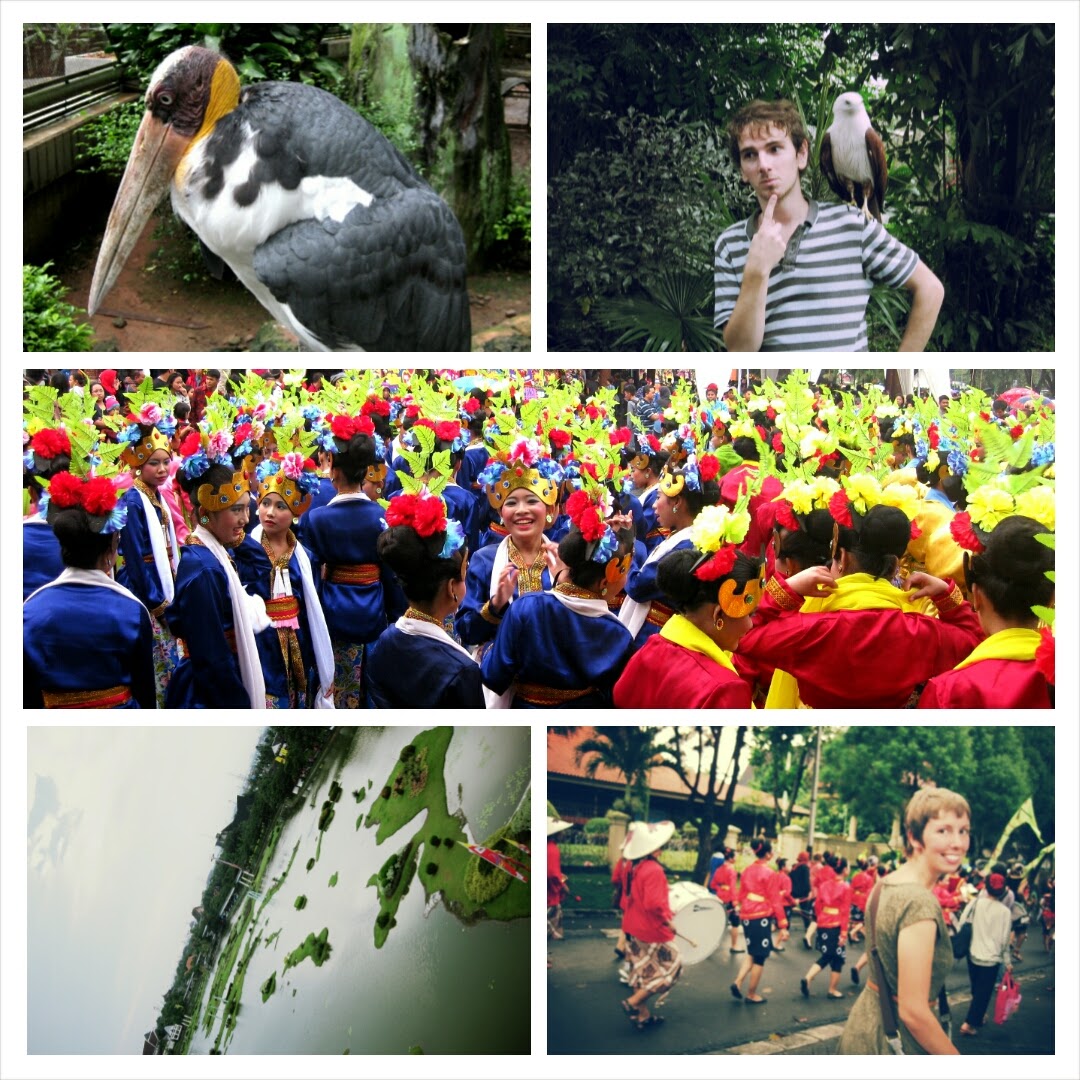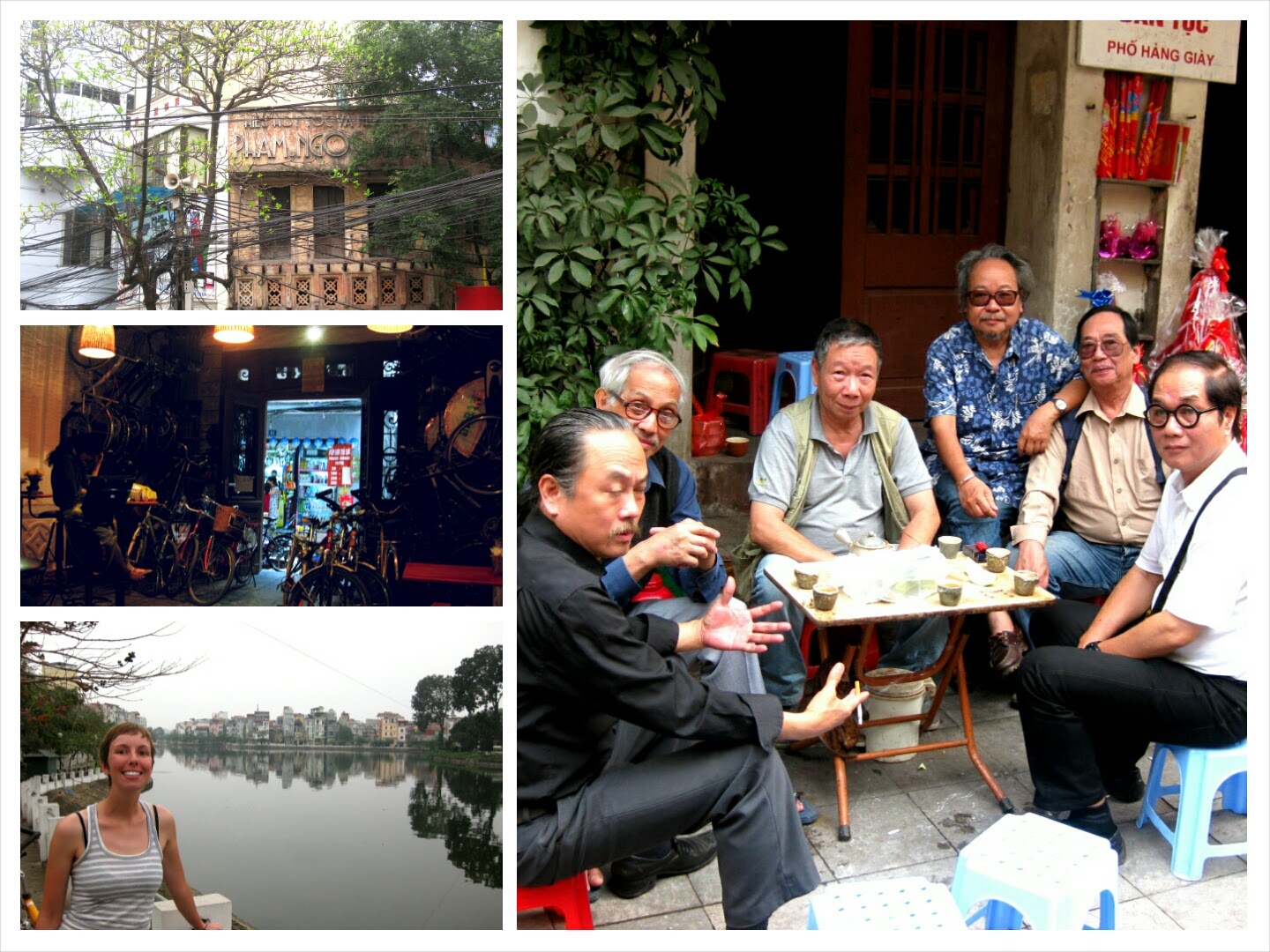The first thing we did after marvelling at the island was sort out a tour to the Komodo National Park. A small boat took us out to Rinca island, where we were greeted with a 'beware of crocodiles' sign and a bunch of guides armed with forked sticks. They seemed very knowledgeable and chilled - only later did we hear that one had been bitten by a dragon a couple of weeks back and was still in hospital at the time! Oo-er...
Thankfully no-one got ambushed while we were there. I wasn't expecting to see many dragons but we were very lucky and saw several 2-3m long adults (huge enough when they're in the wild, can run faster than you and have poisonous saliva), plus a couple of younger, more active ones which loped about flicking their tongues and looking sinister. It was like being on the set of walking with dinosaurs, with added scaliness.
Incredible as the dragons were, our next wildlife encounter was even more awesome. We were taken to a snorkel site a little way off where we saw black fins sliding in and out of the water. I jumped off the side of the boat and was immediately face to face with a massive manta ray! Its body was almost completely flat with a wide mouth, long thin tail and a wingspan of 3m or more. It took me a while to start breathing again, during which time the ray glided silently up to me then pirouetted downwards and away. After that I saw a few more, once swimming with two together. Jon was with a group of three at one point. Being in the water with something that big and strange-looking was one of the most surreal and beautiful experiences I've had. Swimming with a family of 3 giant green sea turtles swimming in some coral later that day was nice too.
Kanawa Island has a PADI dive centre and given the massive variety of sea life it seemed the perfect place to give scuba diving a go. We were put in a group with fellow islanders Jos and his son Bjorn from Holland, kitted out with wetsuits and seriously heavy scuba tanks and waddled with some trepidation to the shallows for our lesson. We practiced breathing through the respirator, a very strange thing especially as the bubbles are so loud, and then swopping to our buddy's emergency supply. When we went to deeper water, teeming with fishies and coral, I found it quite tricky to get the buoyancy level right and had to be helped a couple of times when I started floating inexorably upward (I hadn't thought being unable to sink would be my primary concern).
After Komodo, we went back to Bali for our final week in Asia. En route we passed through Labuan Bajo, which is a small port town mainly serving as a transport hub for Komodo and Flores island - however it has the best Greek restaurant In The World (in my experience anyway). Why it is there is beyond me, but we just shrugged and enjoyed our chicken souvlakis. And drank local speciality Kopi Ende, which is brewed from coffee beans roasted with ginger and is fiery and wonderful.
Back on Bali we felt we had to stay at Kuta beach, where surfing came to Asia and the backpacker tradition pretty much began. As you might expect, it is now mostly up-market resorts and malls mixed in with tat-touting souvenir stalls and a lot of boisterous (but friendly) Australians. However, the surf culture side of things does continue and it was cool to see people wandering up and down with their boards. Plus, Balinese Hinduism is in evidence all over, with temples and houses festooned with bamboo decorations, offerings and incense. In the sky there are always kites, which sometimes have loud whistles or buzzers attached. It's a very lively place!
As always we wanted to get out on mountain bikes, so booked a day with Infinity Rides. Our guide took us high up above Lake Batur to ride some lovely sweeping single-track down volcanic foothills. It was good to get out of the city and go back to high-fiving farm kids again like in Vietnam. The trail was the most challenging we've ridden since back at x-biking Chiang Mai, Thailand (which is kinda another level), and reminded me a lot of some of the most fun bits back in Sheffield. There was a tricky soft sand section through a dry riverbed and some very technical rocky gullies. At one point I was riding slowly along a narrow track across a steep slope, and managed to hit a root and go straight over the handlebars. Jon was behind me and thought this very funny.
We were riding with an Australian chap called Bernie who videoed us all with his Go-Pro helmet camera - think I may need to get one of those. We kept riding short blasts and then stopping to chat about it, or eat guava fruit off a tree, or once to try and find a snake eating a frog (which was making a lot of noise but remained hidden). It felt like a proper Sunday ride out.
In Kuta there is a water theme park called Water Bom, where we spent a very fun day trying out all the water slides. It was very impressive - kind of like a water based Alton Towers, with pools and a 'lazy river' to tube between all the brightly coloured rides. Lots of them had rafts to sit in as you zipped along through rapids and drops, some of which were rather scary. For one ride called 'Climax' I had to get into a launch chamber which counted down from 3 before dropping me down a near vertical chute... that was my favourite. It was great to wander about getting wet outside all day and not be cold!
 |
| Odd pictures on the left from the trick 3D art museum. No fights with octopuses or sea snakes actually happened. |
I wanted to have a bit more beach time in a quieter bit of the island, so we went down to Uluwatu on the Bukit Peninsula for a couple of days. It's the Southern-most tip of Bali and juts into the Indian Ocean. The waves are bigger and so the surfers are more experienced, and it was particularly fun to clamber between little surf shops down to a cave which opens to the sea, then back up the other side to watch them all from a cafe terrace (I know lots about surfing now. Apparently it is customary to dismount by quickly extending all limbs outwards and leaping back into the water).
We rented a moped to visit a couple more beaches, one of which was so secret that we had to go down a narrow track signposted for a hostel and then find some steps round the back which led down the cliff face to the sea. There was no-one else around except some shell collecting locals. Next we visited less secret but if anything harder to find Bingin beach, which is accessible only via a maze of footpaths stemming from a maze of back roads with very little signage at all. For a while we had a train of other people on mopeds following us, evidently hoping (despite evidence to the contrary) that we knew where we were going. When we did find the beach it was worth it - it was sandy, had a great ramshackle collection of buildings stretching across the cliffs and there were excellent smoothies to be had.
Uluwatu temple is perched on top of some very high wave-battered cliffs right on the tip of the peninsula. We were a bit dubious about it at first as it is home to some monkeys of bad reputation, which we'd seen about enough of back in Ubud. However they didn't trouble us and it was a good place to go for a bit of a walk and see some culture. The temple was originally built for Bali's animist religion, which was later absorbed into the current Hinduism. It is one of seven all built within eye sight of one another around the coast to worship the gods of the sea.
Our flight out of Bali was in the late evening so we had chance for one final Southeast Asian meal, at Jimbaran Bay close to the airport. The restaurants on the beach front all serve the same style of grilled seafood, and are all quite expensive. However we had a tip off the internet to try asking for a discount, which we tried at two places before they gave us a reasonable offer. It involved lots of dramatised whispering and going to see a pointed-out member of staff who took me aside and explained that they could perhaps do us a deal for exactly the budget I'd stated. The end result, though, was that we had a brilliant meal of grilled white snapper and marinated prawns with rice, veg and soup, while sitting at a table on the sand watching the sunset serenaded by a mariachi band.
The final, somewhat fitting end to our Asian Adventure was negotiating the final leg to the airport, only a few of kilometres away. We tried asking taxi drivers but everyone was determined to rip us off, telling us that it was 'impossible' to get a cheaper price after dark and that the airport was 'very far' (despite the planes thundering overhead for take-off and landing). Somewhat frustrated we decided to go with our typical walk-for-ages-carrying-all-our-luggage technique which always works out, even when we get a bit lost on the way. I don't think many people foot it into Denpasar International Airport but we did. We arrived sweaty but in time for a celebratory matcha milkshake and a coffee bun (Asian specialities both, which will be sorely missed), paid a very last minute fine for overstaying our visa (rather worrying being taken to a back office at a foreign airport) before finally catching our flight.
And so ends the tale of our mostly un-planned, fantastically exciting, rich-beyond-all-expectations 8 month voyage across South East Asia! We are basically coming back with a much longer list of places to visit than we set out with, but that's no bad thing. It has been a marvelous, fun and surprisingly cheap experience and we will definitely be going back! Someday.
- Kath


























































